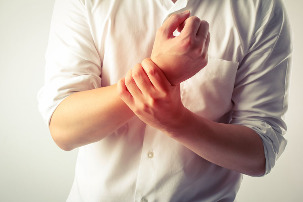Osteochondrosis – the disease, which is one of the most popular in the world. Most of the people after 35 years, the osteochondrosis of the cervical spine in one Form or another. Lately there is a Trend to increase the number of with severe disease and rejuvenation of the disease, reduce the lower age threshold. This is due to the fact that a growing number of people around the world engaged in sedentary work and sedentary way of life. Meanwhile, the disease is dangerous enough, and everyone should know what it is – the osteochondrosis how it manifests itself and how it is treated, in the position to recognize its symptoms and in time with treatment.

Causes of cervical degenerative disc disease
Osteochondrosis is one of the few diseases that is characteristic only for the people. In the case of other animals this disease is not occurring. The reason for such a peculiarity of human beings as two-legged is. The vertical Position of the spine means that the vertebrae press on each other, and bone and cartilage of the spine gradually deteriorated and deformed. The spine of the people begins with the cervical spine. Only in this Department seven vertebrae – from the first to the seventh. The vertebrae, separated intervertebral discs. The cervical spine is a particularly susceptible part, which first and foremost, with the increased mobility of the vertebrae in this area. In the neck area of the disease is reflected especially on the hard drives, which are a weak point in the structure of the spine. The prevalence of cervical degenerative disc disease help, also such factors as the small size of the vertebrae and the relative weakness of the neck muscles. Also on the development of cervical degenerative disc disease a big influence on the defectiveness of the blood supply to the cartilage. Thus, the development of the disease is a complex and lengthy process and has not a single cause. Although a connection between the seat of activity of the person and the illness the presence in him of cervical degenerative disc, however, the disease is not rare, and in trained people, especially athletes, due to the increased load on the neck and heavy items spine when lifting. In the elderly, in General, the removal of vertebrate structures – it is an inevitable process in connection with the aging of the organism and weakening its defenses. However, the most common pathological type of cervical degenerative disc disease, in the play the main role or external or internal negative factors.
Factors affecting the development of degenerative disc disease of the neck:
- Posture disorders
- Curvature of the spine
- Injuries of the back
- Overweight
- Heavy physical work
- Sedentary Work
- Lack of exercise
- Metabolic disorders
- Frequent Hypothermia
- Uncomfortable posture during sleep
- Stress, fatigue
- Hereditary factors
- Infectious diseases
- Individual characteristics of the physique, for example, a too long or too short neck
Degree of development of cervical degenerative disc disease
The disease has four stages. Not always easy to determine the stage of the disease, on the analysis of the symptoms because sometimes, the degree of degradation of bone-and cartilage tissue may not be evidence necessarily, observed in a patient.

The first degree
Begin the destructive processes in the bone-and cartilage tissue of the vertebral body. In General, in this stage of osteochondrosis of the cervical spine symptoms are mild. Ill Co or not even notice, or not connected with diseases of the spine and attribute to Stress and exhaustion.
The second stage
The decrease in the intervertebral disc height begins, on its surface, the cracks appear. Symptoms of cervical degenerative disc disease in this Phase manifests itself in constant pain, weakness, numbness, single parts of the face.
The Third Stage
Formed by herniated discs, by separation of the cervical vessels and muscles. In one patient, dizziness, pain will appear in the back of the head.
The fourth degree
Osteophytes appear – bony growths of tissue, for the protection of the vertebrae of the load, which leads to a violation of the nerves. This leads to a stiffness of the movements and damage to adjacent joints.
Cervical Osteochondrosis: Symptoms
The main symptoms of osteochondrosis of the cervical spine:
- Pain in the neck and shoulder area
- Weakness of the muscles
- Increased Sweating
- Numbness in the hands
- Co-ordination disorders
- Dizziness
- The deterioration of vision and hearing
- Increased Blood Pressure
- Headache
This is typical of degenerative disc of the cervical spine symptoms disease may be present in all stages of the disease. In most cases, there are only a few symptoms from the list, and the Rest can be a Person, faced for the first time with similar symptoms of the disease, lack of, not always suspected when a cervical osteochondrosis. Thus, it may be to the various doctors, therapists, cardiologists, neurologists, surgeons. And the correct diagnosis in the results can be made with considerable delay.

Syndromes
When cervical osteochondrosis occurs a couple of syndromes, that is, the typical conditions that a complex of characteristic features. They manifest themselves depending on which nerves and arteries are affected as a result of the disease:
- Syndrome of vertebral artery
- cardiac syndrome
- hypertensive syndrome
- radicular syndrome
- Syndrome cervical migraine
The syndrome of the vertebral artery – one of the most unpleasant and the most dangerous complications of cervical osteochondrosis. It is due to the fact that the reduced flow of blood through the arteries, the along the spine and the brain. The syndrome manifests itself in such symptoms, such as systemic or recurring dizziness, hearing loss and Vision. In some cases, it may be fainting. Often there is a variant of the syndrome, she concludes that, in the normal condition the blood flow in the artery is normal, but when turning the head in one direction or the other, he can fall drastically. Cardiac syndrome develops when the nerve roots press, the Innervation of the diaphragm or the chest muscle. As a result, the Patient can experience pain, similar to that of cardialgia, although the direct effects on the heart happens. But for the syndrome may be due to such symptoms as tachycardia, hypotension and heart rhythm disturbances. Hypertensive syndrome is also one of the most dangerous complications. In contrast to vertebral artery syndrome, there is a feeling of pressure does not cause any arteries, but veins that it is difficult, the outflow of blood from the head. The syndrome leads to an increase in intracranial pressure, and the can in such symptoms, such as nausea, vomiting, headache The syndrome of cervical migraine has little about its Genesis with the classic migraine. It manifests itself in the most pain in the back of the head. The pains are paroxysmal in nature, take up to ten hours, and accompanied by vomiting. Radicular syndrome – the most common syndrome in osteochondrosis of the cervical spine. Called feeling of pressure each individual nerve roots of the spine in the neck. It can result in pain in the area of the neck, neck, shoulder blades, shoulders, numbness and weakening of the tone of the separate sites of the hands (up to the impossibility of any manipulations) and neck. Very often, several syndromes or single symptoms, are observed in the typical for a variety of syndromes. To see how, in the case of the osteochondrosis of the cervical spine, symptoms of the disease are varied and not always the Patient is able to correctly identify him as the cause of this. If you meet with similar symptoms, then this is a reason for going to the doctor.

Diagnosis
For the diagnosis it is recommended that in the therapist. He gives direction to specialists – orthopedic surgeons, the spine, a neurologist. For the diagnosis of the following types of studies will apply:
- Radiography
- Computed tomography
- Magnetic Tomography
- Ultrasound examination of the blood vessels of the neck
X-ray enables the determination of the displacement of the vertebrae, the deposits, the presence of growths – osteophytes and salt, the seals of the Windows. Computed tomography consists in the creation of a series of x-ray images, the volumetric representation of the body, in this case the cervical spine. It allows you to have detailed portrayal of the degree of the pathological process – the compression of the nerves, the structure of osteophytes, the amount of drives, etc. the magnetic resonance imaging is based on the physical effect of nuclear magnetic resonance, is still further structural image of the spine. Sonography of the vessels of the neck helps changes in the blood flow in the large vessels of the neck, caused by the disease.
Treatment of cervical degenerative disc disease home
How to treat osteochondrosis of the cervical spine to be home and safe again, he is anyway? For dealing with the disease, the medicine, many of the methods developed. Some of the possibilities of the treatment and applied at home can. But this process is lengthy and a complete cure is unlikely, especially in the elderly. However, slow down and stop destructive processes in the spine possible in each Phase of the disease. In the early stages of the disease methods, in General, conservative. For the treatment of cervical degenerative disc several ways diseases are:
- Drugs
- Physiotherapy
- Physiotherapy
- Massage
- Special means for fixation of the spine
If the disease has spread in the last Phase, and a serious destruction of the bone occurs and cartilage structure of the spine, the diseases for the treatment of degenerative disc in the neck can spine be used and the surgical procedure.
Drugs
The following types of drugs are:
- Chondroprotectors
- Vitamins
- Analgesics
- Anti-inflammatories
- Antispasmodics

In the case of acute pain syndrome, associated with osteoarthritis, the top priority is its elimination. Usually examine oral medicines, such as painkillers or Baralgin, but if your inefficiency is in the most severe cases, novocaine Blockade. If muscle cramps apply antispasmodics. The greatest efficiency in the case of osteochondrosis shows created drug against this disease, although it is possible and the use of other muscle relaxants. As an anti-inflammatory and analgesic ointments, which are non-steroidal drugs can. In the case of syndromes, the with impaired blood circulation and blood supply to the brain – hypertensive and A. vertebralis syndrome, the drugs, the unwanted effects of this Syndrome – means the lowering of the pressure and nootropics.
Physiotherapy
Physiotherapy – the easiest and cheapest way for the treatment of cervical degenerative disc disease and, at the same time, enough powerful. The treatment therapy can be carried out and in the home. In the case of osteochondrosis intensity of the workout does not play a crucial role in the process, you need only your regularity. First and foremost, exercise is used to strengthen the muscles of the neck, the make, the insufficient functionality of the spine to support and help him, the weakened vertebrae. For the strengthening of the neck muscles daily lessons are recommended. They can be complicated a very simple, consisting of rotation and inclinations of the head in different directions, and more on how to help Ironing the neck by muscles of the Hand. You you can at home and at work. For example, if the Job is a sitting, then it makes sense, such an exercise after an hour of sitting at the table, or Monitor. However, they meet only outside the period of exacerbation of the disease and in the absence of pain. Otherwise, you are able to only worsen the condition. Not less effective and strengthen the muscles of the shoulder girdle, for example, with the help of regular work with light dumbbells. However, strength training (weights, dumbbells) is contraindicated. It is also helpful to regular swimming lessons, unloaded spine.
Physiotherapy
Physiotherapy methods for the treatment, the effects on the body some of the physical fields and radiation. A positive feature of physiotherapy is that there is a minimum number of contraindications. For the treatment of osteochondrosis the following methods of physiotherapy:
- Ultrasonic effect
- Laser therapy
- Effects of magnetic field
- The effect of the electric current (electrophoresis)
The magnetic field homeopathically on the damaged tissues of the body and has anti-inflammatory and analgesic effect. Ultrasound improves the metabolism in tissues, relieves swelling. The same is also true for laser therapy. Electrophoresis is usually in connection with drug, because the application of the electric current accelerates their Assimilation by the body.

Massage
Massage reduces the increased muscle tone, spasm, and reduced the flow of lymph, causing swelling. The procedure improves blood circulation in the affected area, which stops the process of destruction of the intervertebral disc.
Other methods of treatment
What not to do in case of cervical osteochondrosis when the classical methods of home treatment help? To reduce the load on the neck part of a special fixing collar of a trench is, the signed up to the neck in a constant position. It is recommended to dress, during exacerbations of pain syndrome or with prolonged sedentary work. In order to avoid exacerbations, you should also arrange a place to sleep. The pillow should not cause curvature of the neck, and the mattress must be hard and smooth. In some cases, special adjustments for sleep orthopedic mattress and pillow can help.


































